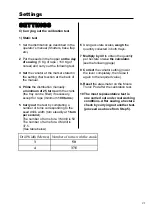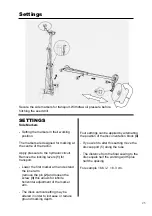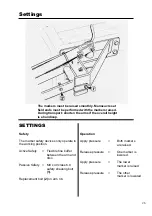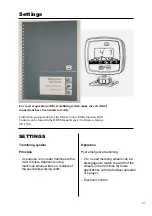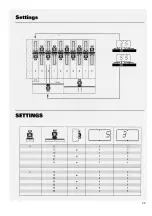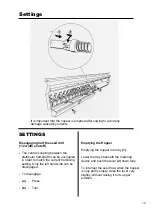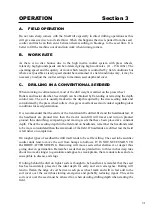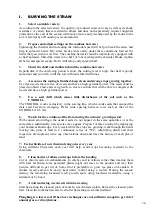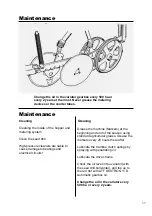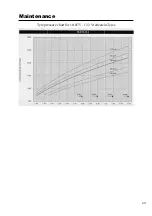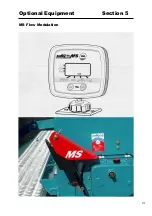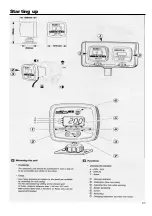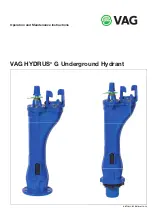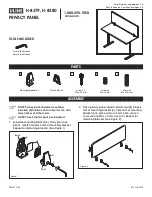
OPERATION
Section
3
A. FIELD OPERATION
Do not turn sharp corners with the Uni-Drill especially in direct drilling operations as this
will give massive disc to soil side thrust. When this happens the disc is parted from the seed
coulter and trash can then enter between them resulting in blockage to the seed flow. It is
better to lift the machine out of and into work when turning corners.
B. WORK
RATE
As there is no disc bounce due to the high inertia coulter system with press wheels,
relatively high ground speeds can be tolerated giving high work rates. (11 - 15 Km/hr). The
operating speed and the quality of work which results is controlled by field conditions but
where ever possible a steady speed should be maintained. As field conditions vary, it may be
necessary to adjust the coulter settings to maintain seed depth and cover.
C. DRILLING IN A CONVENTIONAL SEEDBED
When working in cultivated soil, most of the drill weight is carried on the press wheel
Rollers and tractor drawbar. Seed depth can be obtained by Extending or retracting the depth
control ram. The soil is usually tracked to the depth required by the disc seeding units and
consolidated by the press wheel rollers - this gives excellent seed soil contact equalling ideal
conditions for seed germination.
It is recommended that the centre of the field should be drilled first and the headlands last. If
the headlands are planted first then the tractor and drill will travel and turn on planted
ground, thus disturbing, compacting and moving seeds that have been placed at a constant
depth. Check the seeding depth in the field and on headlands, remember the headlands tend
to be more consolidated than the remainder of the field. If headlands are drilled last the field
is left tidier on completion.
On rougher types of seedbed the drill itself tends to be self levelling. The seed tube and disc
coulter units tend to move the soil from humps to hollows. IT IS NOT NECESSARY TO
HARROW AFTER SOWING. Harrowing will move seeds either shallower or deeper thus
giving uneven germination. Remember seeds that are planted two to three inches deep take
about two weeks longer to germinate and appear as weak plants, that are under stress and are
susceptible to disease and slugs
If rolling behind the drill on lighter soils is thought to be beneficial, remember that the seed
has been accurately placed at the ideal depth for early and even emergence. Rolling will
tend to flatten the ridge of soil between each press wheel mark and will in fact add to the
soil cover over the seed thus slowing emergence and probably reducing vigour. This extra
soil cover over the seed must be allowed for, when deciding drilling depth when starting the
field.
31
Summary of Contents for UNIDRILL 300
Page 1: ...August 2001...
Page 5: ...4 Safety Regulations...
Page 7: ...6 Warning Symbols 1...
Page 9: ...Safety Instruction Decals 8...
Page 10: ...Safety Instruction Decals 9 25...
Page 29: ...28...
Page 41: ...Maintenance Tyre pressure chart for 10 0 75 15 3 Vredestein Tyres 40...
Page 42: ...Optional Equipment Section 5 MS Flow Modulation 41...
Page 44: ...Starting up 43...
Page 45: ...Starting up 44...
Page 46: ...Operation 45...
Page 47: ...Operation 46...
Page 48: ...Operation 47...
Page 49: ...Operation 48...
Page 50: ...Operation 49...
Page 51: ...50 D E...
Page 55: ...Dragarm Seeding Unit 47 48 54 Parts list...
Page 59: ...Drawbar and Rear Axle Assembly 58 Parts list 47 48 45 1 2 49 3 4 50 51 52 53 53 A B 55 54 35...
Page 61: ...Drive wheel Assembly 60 Parts list 26...
Page 63: ...Seed Box Assembly S900520 S901537 62 Parts list...
Page 65: ...Seed Box Drive Unit 64 Parts list...
Page 67: ...Multiplicator Parts list 66...
Page 69: ...MS Flow Modulation Parts list 1 3 2 7 10 8 9 11 6 5 4 15 14 12 13 68...
Page 71: ...Linak Actuator Tramline Mechanism Parts list 1 5 2 7 6 4 3 9 8 70...
Page 73: ...Seedbox Metering Parts Parts list 10 12 11 8 6 5 4 3 9 2 1 7 72...
Page 75: ...SPI Vertical Lift Marker 74 Parts list...
Page 77: ...Moore Vertical Lift Marker 17 13 16 47 48 Complete disc hub assembly 14 15 74 Parts list...
Page 79: ...Electric Parts Sensors Parts list 1 4 3 2 76...
Page 86: ...Calibration Charts Calibration charts for Rape Barley Peas and Field Beans 83...
Page 87: ...Calibration Charts Calibration charts for Oats Mustard Phacelia and Radish 84...
Page 88: ...Calibration Charts Calibration charts for Lucern Linseed Rye grass and Clover 85...
Page 89: ...Notes 86...





